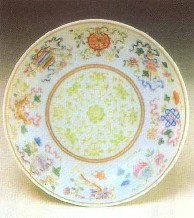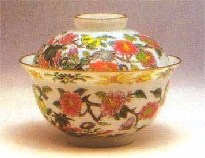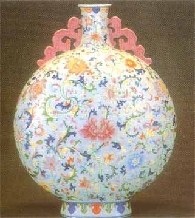Chinese people have producedporcelainfor a very long time. To some extent, the world became acquainted with China through its chinaware and porcelain, which was often used as a yardstick in evaluating Chinese civilization. For over 2,000 years, Jingdezhen was known as "the porcelain capital" of the world. The City of Jingdezhen in East China'sJiangxi Province, which was called Xinping in ancient times, began to make porcelain as early as 200BC in theHan Dynasty(206BC-AD220). During the reign of Emperor Jingde (1004-1007) of the Song Dynasty (960-1279), all of the products made here bore the royal Jingde mark, and the name of the city was therefore changed to Jingdezhen (Jingde Town).
For centuries, the city was considered as China's most important center for porcelain production. Here,ceramicswere produced as far back as the Han Dynasty (206-220BC). The imperial porcelain was so exquisite that it was described as being "as white asjade, as bright as a mirror, as thin aspaper, with a sound as clear as a bell".
Today, Jingdezhen remains a national center for porcelain production. The most famous types of porcelain from Jingdezhen arefamille-rose porcelain,linglongporcelain, blue-white porcelain and color-glazed porcelain.
Famille-rose porcelain
Famille-rose porcelain, so called its pink enamel, first came into being during theYongzhengreign (1723-1735) in theQing Dynasty(1644-1911) and continued to be made throughout theQianlongreign (1736-1795) and beyond. Main materials and techniques used to make the porcelain were all introduced from abroad in the beginning.
When makingfamille-rose porcelain, craftsmen fired glass whiteness onto plain porcelain, creating patterns withChinese paintingtechniques and then baking it in a kiln.
During the Kangxireign, there were only a few works offamille-rose porcelain, whose color paintings were also very simple -- mainly patterns of flowers, clouds and dragons. During the Yongzheng reign, the porcelain enjoyed great improvements. Both the porcelain and decorations produced in this period featured a most delicate quality and brilliant color; these pieces are among the most highly prized works of this type of porcelain.
The famille-rose porcelain produced in the Qianlong reign saw an obvious change -- other colors such as green, yellow, blue, carmine or purple, were added to the white porcelain. At that time, the porcelain was no longer as delicate, crystal-like and colorful as that produced in the Yongzheng reign. When it came to the Jiaqing and Daoguang reigns,famille-rose porcelain mainly inherited a form of traditional development and did not witness much improvement. The ceramic glaze used was not very refined and featured strong hues.
During the Xianfeng and Tongzhi reigns, the composition offamille-rose pictures became quite complicated, although the painting skills were simple and the materials used were rough. Thefamille-rose porcelain produced during these periods featured comparatively faint hues, and, in order to make the colors more brilliant, gold was applied to thefamille-rose base.
The characteristics listed above are the major criteria used to distinguishfamille-rose porcelain produced in different periods during the Qing Dynasty.
Famille-rose porcelain wares in the Qing Dynasty mainly included pots, bottles, wine vessels, jars, basins, plates, urns, boxes, and so on. The patterns mostly included dragons and phoenixes, flowers, landscapes, human figures and themes from legends. Subjects on the porcelains often came from paintings of famous painters at that time.














